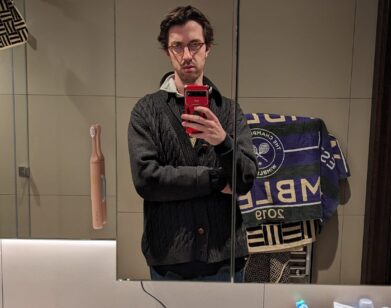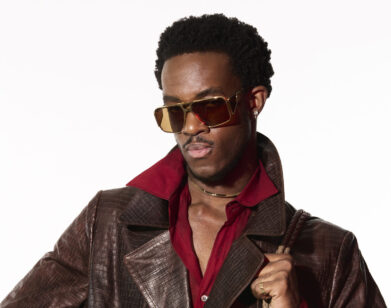Sergei Polunin: The Dancer, The Artist
SERGEI POLUNIN IN NEW YORK, SEPTEMBER 2016. PHOTOS: THOMAS WHITESIDE. STYLING: MAC HUELSTER. HAIR: BRIAN BUENAVENTURA/MANAGEMENT ARTISTS FOR CUTLER /REDKEN. MAKEUP: JUNKO KIOKA/JOE MANAGEMENT USING CHANEL ROUGE. PHOTO ASSISTANTS: RETO STERCHI AND JOSE ALVARADO. DIGITAL TECHNICIAN: CAITLIN FRACKLETON.
Two years ago, Sergei Polunin decided to quit ballet and become an actor. He would dance one last farewell: a four-minute piece set to Hozier‘s “Take Me to Church,” choreographed by his close friend Jade Hale-Christofi and filmed by director, photographer, and artist David LaChapelle. The piece would also mark the culmination of Dancer, a documentary on Polunin’s life produced by Gabrielle Tana and directed by Steven Cantor.
An only child born and raised in Ukraine, Polunin moved to London as a young teenager to study with the Royal Ballet. When he was only 19, he became one of the Royal Ballet’s principal dancers, and audiences began buying tickets to see him perform two years in advance. A narrative formed around his public persona. Polunin was the “bad boy of ballet”—incredibly talented and extremely volatile. He was a tattooed party animal who sabotaged his own career by resigning from Royal Ballet in a furor at 22.
Dancer, however, tells a different story. Released in select theaters and on VoD last Friday, the film focuses on the family trials Polunin endured growing up: his grandmother and father leaving Ukraine and working menial jobs in Western Europe to support his ballet education; the pressure from his family to become successful; leaving his parents behind at 13 and moving to a foreign country; his parents divorce while he was a teenager. Another major theme in the film is the existential angst that comes from achieving one’s goals: What do you do when you rise to the top of your field—the only field you’ve ever known—when you’re just 19? What comes next?
Since it was first released in February of 2015, Polunin’s “Take Me to Church” has garnered over 16 million views on YouTube, and the now 26-year-old has reconsidered his retirement. “It’s amazing how many people watched it,” he says over the phone. “It’s amazing how such a small piece of art can be such a powerful thing for people.”
EMMA BROWN: I wanted to know first how you met David LaChapelle.
SERGEI POLUNIN: We met during the shoot, “Take Me to Church.” At the beginning, we worked, but we didn’t really talk. We were in Hawaii for five days together, and the shoot took probably nine hours a day, but we didn’t really speak. It was a strange experience. Then the second time, he did a shoot with me for his book. Again, we didn’t really talk much. And then, I think it was just something magical and special—it was like some amazing connection happened. I could not imagine working without him. He was a special person in my life who really influenced me in a very different way. Now I want to become an artist, rather than one thing, like a dancer, or a movie star, or a choreographer. I realized what an artist is and what it is to be an artist. I found it interesting to see his life and how he works, how he creates. He started to make me question dance, because he loves dance more than anything. I was like, “Okay, maybe I should look at dance from a different angle.” He inspires me.
BROWN: Are you working on another project together now?
POLUNIN: We will be, because he wants to create a ballet. He has a vision for the future of ballet. I think that’s going to be something very, very unique and special, which ballet needs to make it something fresh.
BROWN: Dancer goes through key events in your life, like moving to London to study ballet, quitting the Royal Ballet, moving to Russia. Do you have any regrets about any of those decisions?
POLUNIN: If you ask about regrets, I normally don’t regret. I enjoy everything, even if it’s bad or good. But I wish I could, instead of destroying things like that, I wish I could build, build, build. Maybe if I’d had the right advisors—mentors—I probably would have done it differently. But that’s the way I act out, and that’s the way I knew how to do it. I could only destroy to build. That was just my way. I wish I could have built without destroying things.
BROWN: Do you still dance everyday?
POLUNIN: I do. I have to. I wake up and I do class straight away, so that gives me a free day to do things. I do it by myself. I do it at home.
BROWN: Do you think you’re still getting better?
POLUNIN: I do. Not many people understand that, but if you open yourself to listening—you don’t even have to exercise—you get better with time. If you open yourself as an artist, as a human being to this experience of growing, you grow anyway. You don’t have to be every day doing the same thing—practice, practice, practice—you can grow. I feel like I’m getting stronger and stronger, and I don’t practice as much as I used to.
BROWN: Dancer talks a lot about how you build up your whole life to become a principal dancer at one of the best companies in the world, and then when you get there, it becomes, “What’s next?” Do you still feel that, no matter what you do, there’s always a “What next?”
POLUNIN: What made my mind go free is that I wanted to become an artist. As soon as I said to myself, “Oh I’m not a dancer; I’m not an actor,” it made me so free to do anything. It made me free to not rush, to not be scared of things and say, “Oh, I have no time,” or, “I’m not going to make this or that.” As an artist, you have a choice. That gave me the freedom to do what I want to. I can one day do dance, and the next maybe do a movie, and then maybe I can choreograph, or work with different photographers for fashion shoots, or different art forms. You’re never stuck. You’re going at a different level. You’re sucking in things, rather than closing. You’re trying things out. I feel like I’m a kid again. Artists are kids. I feel like I’m six years old.
BROWN: What things other than dance inspire you? You mentioned fashion shoots and acting.
POLUNIN: Fashion was very important to me because I could practice my acting skills, I could practice working with the camera, I could work with amazing photographers. It just gave me a different field of work. I’m really close to participating in a movie—it starts in December, so that’s going to be a new journey. It’s a new art form I want to try. And creating my own dance with my dance projects, and working with artists with David and Ilan Eshkeri who did the music for our documentary.
BROWN: How did the documentary come about? Were you approached about it, or was it something you decided you want to do?
POLUNIN: I was approached about it. A friend of mine, Julie Kavanagh, wrote an article about me in Intelligent Life, and she was a friend of Gabrielle Tana, who approached me [saying] that she wanted to do a narrative movie. Then later, she realized, “Oh, there’s something interesting here for you to do on your own life”—on my life. She said, “I think it’s good to do a documentary,” and it took years to trust, because I didn’t really know what they were digging into. It took a long time to be okay with it. It’s strange because you don’t really want cameras around. It’s like, just let me live my life.
BROWN: It must be weird to have them talk to all of your friends and your family about you.
POLUNIN: Yeah. I worried that they were going to say something bad about my mom. You don’t know what you’re dealing with at the beginning.
BROWN: Has everyone seen the documentary?
POLUNIN: My mom did when I watched it with David for the first time. I love the editing and I love the music, and Gabrielle is a special person in my life. She actually guided me through things, so she became a big part of the journey. Even though she was making a documentary about me, she was actually a guiding angel inside of it, and supported me. She said, “If you want to become an actor, I will help you there. If you want to do this or that.” She became a very unique and important person in my life.
BROWN: When you were growing up, did you get exposed to many art forms other than ballet? Did you watch a lot of movies, for example?
POLUNIN: I was very, very inspired [by movies]. Every night at eight o’clock, 20th Century Fox, the movie would come on from them. It would be every day a new movie, and I was mesmerized. I remember every part of it. I was very inspired by movies. I thought they were very magical. I loved Sylvester Stallone. I never watched Mickey Rourke movies really when I was a kid, but I kept hearing his name, and he was a big inspiration [because of that]. The action heroes were very cool as a kid. You would compare yourself with them—Jean-Claude Van Damme and Arnold Schwarzenegger.
BROWN: Have you gotten to meet any of the actors you admired as a child?
POLUNIN: I’ve seen them in Hollywood. I saw Arnie. I saw Dolph Lundgren. But the person I got close with is Mickey Rourke. He became, not a close friend—we are friends—but he’s a very special person in my life. He called me for my birthday and he gave me his trousers from The Wrestler. He didn’t even really know me, and I thought, “This guy has a really big heart.” He’s a really special guy. I met him in Los Angeles and Moscow, and I saw how big his heart was. Anything I could possibly do in the future for him, or possibly even do a movie with him, that would be a dream. He’s very inspirational to my work. I’ve watched his movies before I do a role.
BROWN: Do people in Hollywood know you as a dancer?
POLUNIN: I have no idea. I haven’t socialized with that many people; I mainly spend time with David. I wouldn’t know what’s happening. I don’t know. I have no idea.
DANCER IS OUT NOW IN SELECT THEATERS IN NEW YORK AND LOS ANGELES. IT IS ALSO AVAILABLE VIA ITUNES AND VOD.







